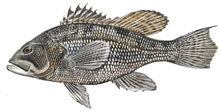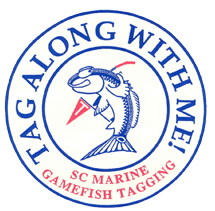Marine - Species
SC Species Regulations for Black Sea Bass
Saltwater Fishing License required.
Black sea bass (Centropristis striata)
General Description
Body very dark. Preopercle finely serrated, lacking a strong spine or spiny lobe, opercle with three flat spines. Dorsal fin single, notched with 10 spines and 11 soft rays. Caudal fin round or trilobite, often with a single upper ray elongated in adults. Large males may possess a bluish hump anterior to the dorsal fin.
Average Size
12 inches, 1 pound;
South Carolina State Record: 8 pounds 3 ounces (1995);
maximum age: approx. 20 years
Habitat
Adults: Temperate reef fishes; inhabit open-shelf and shelf-edge waters 10 – 120 m deep; typically around structured habitat, hard or rocky substrates, and live-bottom.
Juveniles: Occupy nearshore coastal habitats and high salinity, lower estuarine waters; often near oyster reefs, pier pilings, and over live-bottom.
Reproductive Cycle
- Protogynous hermaphrodites: most fish begin as females and later become males. Most fish transition by 2 – 4 years of age. Males are most frequent in fish greater than 4 years old. Approx. size at sexual transition: 8 – 13 inches.
- Females mature at 1 – 3 years of age. Approx. size at maturity: 7 inches. Spawning occurs in offshore waters March – May with minor spawning also occurring during September – November.
- Early larval development occurs offshore. Larvae quickly become bottom dwelling fish and move to nearshore waters and estuaries.
Foraging Habits
- Black sea bass are opportunistic bottom foragers during daylight.
- Adults and older juveniles consume bottom dwelling invertebrates, especially crabs, shrimp, clams, small fishes, and squid. They also graze on organisms attached to hard structure.
- Younger juveniles and larvae consume zooplankton, including amphipods and isopods, and small shrimp.
Availability/Vulnerability to Harvest
- Inshore and coastal distribution is salinity regulated. Juveniles inhabit higher salinity nearshore and lower estuarine waters.
- Seasonal movement is temperature regulated. Individuals inhabit South Carolina waters year-round, older individuals occur over offshore reefs/structure; smaller fish move out of shallower coastal habitats to overwinter in deeper water before returning in spring.
- Conservation concerns: degradation or loss of nearshore and estuarine nursery habitats; intensive fishing pressure from recreational and commercial fisheries.
Literature Cited
Cupka DM, RK Dias, J Tucker. 1973. Biology of the black sea bass, Centropristis striata (Pisces: Serranidae), from South Carolina waters.
Kendall Jr. AW. 1972. Description of black sea bass, Centropristis striata (Linnaeus), larvae and their occurrences north of Cape Lookout, North Carolina in 1966. Fish Bull 70: 1243-1259.
McGovern JC, MR Collins, O Pashuk, HS Meister. 2002. Temporal and spatial differences in life history parameters of black sea bass in the southeastern United States. North Amer J Fish Manage 22: 1151-1163.
Mercer LP. 1980. The reproductive biology and population dynamics of black sea bass, Centropristis striata. PhD Thesis, College of William and Mary. 196 pp.
Mercer LP. 1989. Species profiles: life histories and environmental requirements of coastal fishes and invertebrates (South Atlantic) – black sea bass. U.S. Fish Wildl Serv Biol Rep 82(11.99). U.S. Army Corps of Engineers, TR EL-82-4. 16pp. Accessed: August, 2009
Vaughan DS, MR Collins, DJ Schmidt. 1995. Population characteristics of the black sea bass Centropristis striata from the southeastern U.S. Bull Mar Sci 56: 250-267.
Waltz W, WA Roumillat, PK Ashe. 1979. Distribution, age structure, and sex composition of the black sea bass, Centropristis striata, sampled along the southeastern coast of the United States. Marine Resources Research Institute, Charleston, SC. SC Wildlife and Marine Resources Dept. Tech. Rep. 43. 19pp.
Wenner CA, WA Roumillat, CW Waltz. 1986. Contributions to the life history of black sea bass, Centropristis striata, off the southeastern United States. Fish Bull 84: 723-741.


